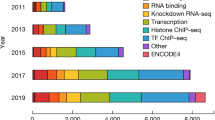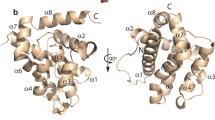Key Points
-
C. elegans is unusual among animals in having operons. These contain co-transcribed genes that make a polycistronic pre-mRNA that is subsequently separated into single-gene mRNAs by 3′-end formation and trans-splicing.
-
Approximately 15% of C. elegans genes are encoded in operons that contain 2–8 genes.
-
Operon-like multigene assemblies are also found in other nematodes and in other species that process their pre-mRNAs using spliced-leader-type trans-splicing.
-
Operons sometimes co-regulate genes that make proteins with related functions. The study of genes that are co-transcribed in C. elegans operons might be a useful tool to identify the proteins that are functionally related to a particular gene of interest.
-
Some functional classes of gene are preferentially included in operons, whereas others are excluded or rarely included.
-
Genes that encode the proteins that function in RNA degradation are the class most frequently included in operons. Other frequently included groups include all of the genes that encode the basic machinery of transcription, RNA splicing and translation, as well as those that encode mitochondrial proteins.
-
We speculate that operons facilitate global regulation of the basic gene expression and energy generation machinery of the cell, in response to signals that are unknown at present.
Abstract
Nematodes are unusual among animals in having a substantial proportion of their genes arranged in polycistronic clusters that are similar to bacterial operons. Recently, a nearly complete database of the Caenorhabditis elegans genes that are transcribed in operons has been produced. Analysis of this database has identified the types of genes that are contained in the operons and the extent to which operons co-regulate genes of related function.
This is a preview of subscription content, access via your institution
Access options
Subscribe to this journal
Receive 12 print issues and online access
$189.00 per year
only $15.75 per issue
Buy this article
- Purchase on Springer Link
- Instant access to full article PDF
Prices may be subject to local taxes which are calculated during checkout


Similar content being viewed by others
References
Lawrence, J. G. Shared strategies in gene organization among prokaryotes and eukaryotes. Cell 110, 407–413 (2002).
Langer, D. et al. Transcription in archaea: similarity to that in eucarya. Proc. Natl Acad. Sci. USA 92, 5768–5772 (1995). One of several papers that report the same operon architecture in bacteria and archaea, especially for operons that contain components of the gene expression machinery.
Jacob, F. & Monod, J. On the regulation of gene activity. Cold Spring Harb. Symp. Quant. Biol. 26, 193–211 (1962).
Spieth, J. et al. Operons in C. elegans: polycistronic mRNA precursors are processed by trans-splicing of SL2 to downstream coding regions. Cell 73, 521–532 (1993). The original report of operons in the C. elegans genome.
Blumenthal, T. & Steward, K. in C. elegans II (eds Riddle, D. et al.) 117–145 (Cold Spring Harbor Laboratory Press, New York, 1997).
Blumenthal, T. Trans-splicing and polycistronic transcription in Caenorhabditis elegans. Trends Genet. 11, 132–136 (1995).
Blumenthal, T. & Spieth, J. Gene structure and organization in Caenorhabditis elegans. Curr. Opin. Genet. Dev. 6, 692–698 (1996).
Huang, T. et al. Intercistronic region required for polycistronic pre-mRNA processing in Caenorhabditis elegans. Mol. Cell. Biol. 21, 1111–1120 (2001).
Sutton, R. E. & Boothroyd, J. C. Evidence for trans splicing in trypanosomes. Cell 47, 527–535 (1986).
Murphy, W. J., Watkins, K. P. & Agabian, N. Identification of a novel Y branch structure as an intermediate in trypanosome mRNA processing: evidence for trans splicing. Cell 47, 517–525 (1986).
Davis, R. E. Surprising diversity and distribution of spliced leader RNAs in flatworms. Mol. Biochem. Parasitol. 87, 29–48 (1997).
Stover, N. A. & Steele, R. E. Trans-spliced leader addition to mRNAs in a cnidarian. Proc. Natl Acad. Sci. USA 98, 5693–5698 (2001).
Vandenberghe, A. E., Meedel, T. H. & Hastings, K. E. mRNA 5'-leader trans-splicing in the chordates. Genes Dev. 15, 294–303 (2001).
Nilsen, T. W. Trans-splicing of nematode premessenger RNA. Annu. Rev. Microbiol. 47, 413–440 (1993).
Denker, J. A. et al. New components of the spliced leader RNP required for nematode trans-splicing. Nature 417, 667–670 (2002).
Nilsen, T. W. Evolutionary origin of SL-addition trans-splicing: still an enigma. Trends Genet. 17, 678–680 (2001).
Zorio, D. A. et al. Operons as a common form of chromosomal organization in C. elegans. Nature 372, 270–272 (1994).
Blumenthal, T. et al. A global analysis of Caenorhabditis elegans operons. Nature 417, 851–854 (2002). The paper presents a microarray and cDNA analysis of the C. elegans genome to identify most of the operons. It also reports the co-regulation of functionally related genes through their presence in the same operon.
Kamath, R. S. et al. Systematic functional analysis of the C. elegans genome using RNAi. Nature 421, 231–237 (2003). The authors analyse most of the C. elegans genes by RNAi, and divide them into functional categories on the basis of their knockdown phenotypes.
Evans, D. et al. Operons and SL2 trans-splicing exist in nematodes outside the genus Caenorhabditis. Proc. Natl Acad. Sci. USA 94, 9751–9756 (1997).
Muhich, M. L. & Boothroyd, J. C. Polycistronic transcripts in trypanosomes and their accumulation during heat shock: evidence for a precursor role in mRNA synthesis. Mol. Cell. Biol. 8, 3837–3846 (1988).
Davis, R. E. & Hodgson, S. Gene linkage and steady state RNAs suggest trans-splicing may be associated with a polycistronic transcript in Schistosoma mansoni. Mol. Biochem. Parasitol. 89, 25–39 (1997).
Blumenthal, T. Gene clusters and polycistronic transcription in eukaryotes. Bioessays 20, 480–487 (1998).
Dufourcq, P. et al. lir-2, lir-1 and lin-26 encode a new class of zinc-finger proteins and are organized in two overlapping operons both in Caenorhabditis elegans and in Caenorhabditis briggsae. Genetics 152, 221–235 (1999).
Zorio, D. A. & Blumenthal, T. U2AF35 is encoded by an essential gene clustered in an operon with RRM/cyclophilin in Caenorhabditis elegans. RNA 5, 487–494 (1999).
Mazroui, R., Puoti, A. & Kramer, A. Splicing factor SF1 from Drosophila and Caenorhabditis: presence of an N-terminal RS domain and requirement for viability. RNA 5, 1615–1631 (1999).
Zhou, Z. et al. Comprehensive proteomic analysis of the human spliceosome. Nature 419, 182–185 (2002).
Jurica, M. S. et al. Purification and characterization of native spliceosomes suitable for three-dimensional structural analysis. RNA 8, 426–439 (2002).
Rappsilber, J. et al. Large-scale proteomic analysis of the human spliceosome. Genome Res. 12, 1231–1245 (2002).
Nomura, M. Organization of bacterial genes for ribosomal components: studies using novel approaches. Cell 9, 633–644 (1976). One of several papers reporting the co-expression of genes that encode RNA polymerase subunits and ribosomal proteins in the same bacterial operons.
Treinin, M. et al. Two functionally dependent acetylcholine subunits are encoded in a single Caenorhabditis elegans operon. Proc. Natl Acad. Sci. USA 95, 15492–15495 (1998).
Clark, S. G., Lu, X. & Horvitz, H. R. The Caenorhabditis elegans locus lin-15, a negative regulator of a tyrosine kinase signaling pathway, encodes two different proteins. Genetics 137, 987–997 (1994).
Huang, L. S., Tzou, P. & Sternberg, P. W. The lin-15 locus encodes two negative regulators of Caenorhabditis elegans vulval development. Mol. Biol. Cell 5, 395–411 (1994).
Page, A. P. Cyclophilin and protein disulfide isomerase genes are co-transcribed in a functionally related manner in Caenorhabditis elegans. DNA Cell Biol. 16, 1335–1343 (1997).
Lercher, M. J., Blumenthal, T. & Hurst, L. D. Co–expression of neighboring genes in Caenorhabditis elegans is mostly due to operons and duplicate genes. Genome Res. (in the press).
Hill, A. A. et al. Genomic analysis of gene expression in C. elegans. Science 290, 809–812 (2000).
Furst, J. et al. ICln ion channel splice variants in Caenorhabditis elegans: voltage dependence and interaction with an operon partner protein. J. Biol. Chem. 277, 4435–4445 (2002). The first paper to use a C. elegans operon as a gene finding tool. It shows that one protein in the operon modifies the activity of an ion channel encoded in the operon when the two are co-expressed in a cell culture.
Nimmo, R. & Woollard, A. Widespread organisation of C. elegans genes into operons: fact or function? Bioessays 24, 983–987 (2002).
Andersen, J. S. et al. Directed proteomic analysis of the human nucleolus. Curr. Biol. 12, 1–11 (2002).
Acknowledgements
We are grateful to P. MacMorris for comments on the manuscript, to J. Ahringer for the communication of results before publication, and to A. Skop, K. Howell, S. Adam, A. Page, A. van Hoof and W. Harper for providing gene lists. The authors are supported by the National Institute of General Medical Sciences.
Author information
Authors and Affiliations
Corresponding author
Glossary
- ARCHAEA
-
An ancient group of organisms that have ribosomes and cell membranes that distinguish them from bacteria. They are often found in extreme environments, such as near deep-sea vents.
- POLYCISTRONIC
-
Clusters that contain several adjacent cistrons (or genes).
- TRANS-SPLICING
-
A process closely related to intron removal, in which a short spliced leader is spliced onto the 5′ ends of mRNAs.
- RNA INTERFERENCE
-
(RNAi). A process by which double-stranded RNA silences specifically the expression of homologous genes through degradation of their cognate mRNA.
- SECONDARY TRANSPORTER
-
A membrane transporter that does not require ATP cleavage for transport.
Rights and permissions
About this article
Cite this article
Blumenthal, T., Gleason, K. Caenorhabditis elegans operons: form and function. Nat Rev Genet 4, 110–118 (2003). https://doi.org/10.1038/nrg995
Issue Date:
DOI: https://doi.org/10.1038/nrg995
This article is cited by
-
Selfish conflict underlies RNA-mediated parent-of-origin effects
Nature (2024)
-
Subnuclear gene positioning through lamina association affects copper tolerance
Nature Communications (2020)
-
Trans-splicing of mRNAs links gene transcription to translational control regulated by mTOR
BMC Genomics (2019)
-
The gastrula transition reorganizes replication-origin selection in Caenorhabditis elegans
Nature Structural & Molecular Biology (2017)
-
Genome-wide identification and evaluation of constitutive promoters in streptomycetes
Microbial Cell Factories (2015)



